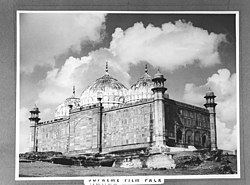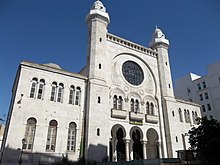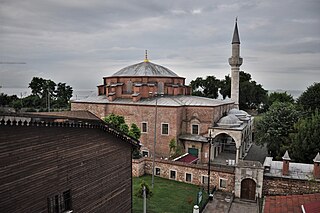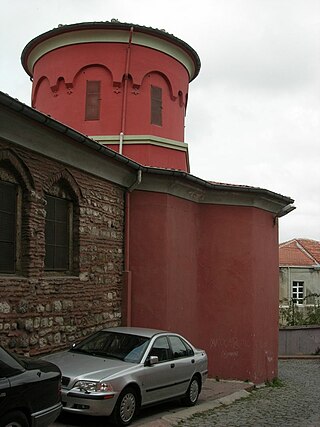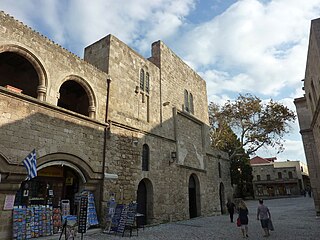Conversion of church buildings
Europe
Albania
- The Catholic church of Saint Nicholas (Shën Nikollë) was turned into a mosque. After being destroyed in the Communist 1967 anti-religious campaign, the site was turned into an open air mausoleum.
- The church of St Stephen in Shkodër was converted into a mosque in 1479 after the city was conquered by the Ottomans.
Bosnia and Herzegovina

The Fethija Mosque (since 1592) of Bihać was a Catholic church devoted to Saint Anthony of Padua (1266). [1]
Contents
Greece

Numerous orthodox churches were converted to mosques during the Ottoman period in Greece. After the Greek War of Independence, many of them were later reconverted into churches. Among them:
- The Church of the Acheiropoietos (Eski Mosque), the Church of Hosios David (Suluca or Murad Mosque), the Church of Prophet Elijah (Saraylı Mosque), the Church of Saint Catherine (Yakup Pasha Mosque), the Church of Saint Panteleimon (Ishakiye Mosque), the Church of Holy Apostles (Soğuksu Mosque), the Church of Hagios Demetrios (Kasımiye Mosque), the Church of Hagia Sophia (Ayasofya Mosque), the Church of Panagia Chalkeon (Kazancilar Mosque), the church of Taxiarches (İki Şerefiye Mosque), the Rotonda of Galerius (Mosque of Suleyman Hortaji Effendi) in Thessaloniki.
- The Cathedral church of Veria (Hünkar Mosque) and the Church of Saint Paul in Veria (Medrese Mosque).
- The Church of Saint John in Ioannina, destroyed by the Ottomans and the Aslan Pasha Mosque was built in its place.
- The Theotokos Kosmosoteira monastery in Feres was converted into a mosque in the mid-14th century.
- The original Pantocrator (Kursum Mosque) church building in Patras.
- The gothic-style Panagia tou Kastrou (Enderun Mosque), the Holy Trinity church in Knights Avenue (Khan Zade Mosque) in Rhodes.
- The Brontochion Monastery, the Hagia Sophia (Ayasofya Mosque), and Panagia Hodegetria (Fethiye Mosque) churches in Laconia.
- The Hagia Sophia (Bey Mosque) in Drama.
- Parthenon in Athens: Some time before the close of the fifteenth century, the Parthenon became a mosque. Before that the Parthenon had been a Greek Orthodox church. Much of it was destroyed in a 1687 explosion, and a smaller mosque was erected within the ruins in 1715; this mosque was demolished in 1843. See Parthenon mosque.
- The Fethiye Mosque in Athens was built on top of a Byzantine basilica. It is currently an exhibition centre.
- The church of Saint Nicholas (Hünkar Mosque) was originally a Roman Catholic church before it was converted into a mosque.

Hungary
Following the Ottoman conquest of the Kingdom of Hungary, a number of churches were converted into mosques. Those that survived the era of Ottoman rule, were later reconverted into churches after the Great Turkish War.
- Church of Our Lady of Buda, converted into Eski Djami immediately after the capture of Buda in 1541, reconverted in 1686.
Spain
A Catholic church dedicated to Saint Vincent of Lérins, was built by the Visigoths in Córdoba; during the reign of Abd al-Rahman I, it was converted into a mosque. [2] [3] [4] In the time of the Reconquista, Christian rule was reestablished and the building became a church once again, the Cathedral of Our Lady of the Assumption. [2] [3] [4]
Middle East and North Africa
Iraq
The Islamic State converted a number of churches into mosques after they occupied Mosul in 2014. The churches were restored to their original function after Mosul was liberated in 2017. [5]
- Chaldean Church of St. Joseph in Mosul, Iraq
Israel and Palestinian territories

Lebanon
- Grand Mosque of Tangier; built on a formerly Roman pagan, and then Roman Christian, site. [7] [8]
Syria
- The mosque of Job in Al-Shaykh Saad, Syria, was previously a church of Job. [9]
Turkey
Istanbul
Hagia Sophia
Following the Ottoman conquest of Anatolia, virtually all of the churches of Istanbul were converted into mosques except the Church of Saint Mary of the Mongols. [10]
- Hagia Sophia (from the Greek : Ἁγία Σοφία, "Holy Wisdom"; Latin : Sancta Sophia or Sancta Sapientia; Turkish : Ayasofya) was the cathedral of Constantinople in the state church of the Roman Empire and the seat of the Eastern Orthodox Church's Patriarchate. After 1453 it became a mosque, and since 1931 it has been a museum in Istanbul, Turkey. From the date of its dedication in 360 until 1453, it served as the Orthodox cathedral of the imperial capital, except between 1204 and 1261, when it became the Roman Catholic cathedral under the Latin Patriarch of Constantinople of the Western Crusader-established Latin Empire. In 1453, Constantinople was conquered by the Ottoman Turks under Sultan Mehmed II, who subsequently ordered the building converted into a mosque. [11] The bells, altar, iconostasis, ambo and sacrificial vessels were removed and many of the mosaics were plastered over. Islamic features – such as the mihrab, minbar, and four minarets – were added while in the possession of the Ottomans. The building was a mosque from 29 May 1453 until 1931, when it was secularised. It was opened as a museum on 1 February 1935. [12] On 10 July 2020, the decision of the Council of Ministers to transform it into a museum was canceled by Council of State and the Turkish President Erdoğan signed a decree annulling the Hagia Sophia's museum status, reverting it to a mosque. [13] [14] [15]
Other churches
- Chora Church in Istanbul (2019) [16]

